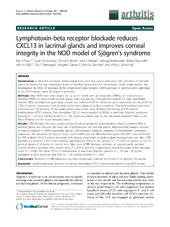Lymphotoxin-beta Receptor blockade reduces CXCL13 in Lacrimal Glands and improves Corneal integrity in the NOD Model of Sjögren's Syndrome
Fava, Roy A.; Kennedy, Susan M.; Wood, Sheryl G.; Bolstad, Anne Isine; Bienkowska, Jadwiga; Papandile, Adrian; Kelly, John A.; Mavragani, Clio P.; Gatumu, Margaret Karimi; Skarstein, Kathrine; Browning, Jeffrey L.
Peer reviewed, Journal article
Published version

Permanent lenke
https://hdl.handle.net/1956/8536Utgivelsesdato
2011-11-01Metadata
Vis full innførselSamlinger
Originalversjon
https://doi.org/10.1186/ar3507Sammendrag
Introduction: In Sjögren’s syndrome, keratoconjunctivitis sicca (dry eye) is associated with infiltration of lacrimal glands by leukocytes and consequent losses of tear-fluid production and the integrity of the ocular surface. We investigated the effect of blockade of the lymphotoxin-beta receptor (LTBR) pathway on lacrimal-gland pathology in the NOD mouse model of Sjögren’s syndrome. Methods: Male NOD mice were treated for up to ten weeks with an antagonist, LTBR-Ig, or control mouse antibody MOPC-21. Extra-orbital lacrimal glands were analyzed by immunohistochemistry for high endothelial venules (HEV), by Affymetrix gene-array analysis and real-time PCR for differential gene expression, and by ELISA for CXCL13 protein. Leukocytes from lacrimal glands were analyzed by flow-cytometry. Tear-fluid secretion-rates were measured and the integrity of the ocular surface was scored using slit-lamp microscopy and fluorescein isothiocyanate (FITC) staining. The chemokine CXCL13 was measured by ELISA in sera from Sjögren’s syndrome patients (n = 27) and healthy controls (n = 30). Statistical analysis was by the two-tailed, unpaired T-test, or the Mann-Whitney-test for ocular integrity scores. Results: LTBR blockade for eight weeks reduced B-cell accumulation (approximately 5-fold), eliminated HEV in lacrimal glands, and reduced the entry rate of lymphocytes into lacrimal glands. Affymetrix-chip analysis revealed numerous changes in mRNA expression due to LTBR blockade, including reduction of homeostatic chemokine expression. The reduction of CXCL13, CCL21, CCL19 mRNA and the HEV-associated gene GLYCAM-1 was confirmed by PCR analysis. CXCL13 protein increased with disease progression in lacrimal-gland homogenates, but after LTBR blockade for 8 weeks, CXCL13 was reduced approximately 6-fold to 8.4 pg/mg (+/- 2.7) from 51 pg/mg (+/-5.3) in lacrimal glands of 16 week old control mice. Mice given LTBR blockade exhibited an approximately two-fold greater tear-fluid secretion than control mice (P = 0.001), and had a significantly improved ocular surface integrity score (P = 0.005). The mean CXCL13 concentration in sera from Sjögren’s patients (n = 27) was 170 pg/ml, compared to 92.0 pg/ml for sera from (n = 30) healthy controls (P = 0.01). Conclusions: Blockade of LTBR pathways may have therapeutic potential for treatment of Sjögren’s syndrome.
Utgiver
BioMed CentralTidsskrift
Arthritis Research & TherapyOpphavsrett
Roy A Fava et al.; licensee BioMed Central Ltd.Copyright 2011 Fava et al.; licensee BioMed Central Ltd.
